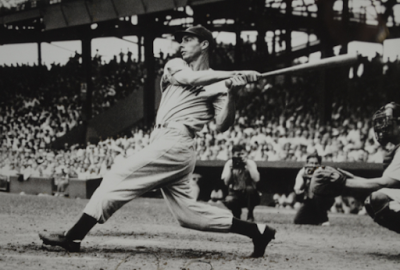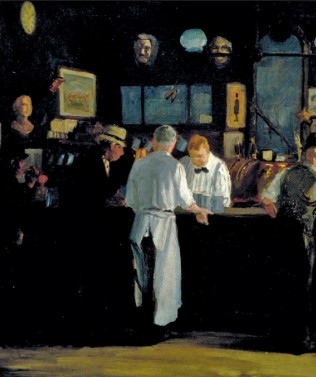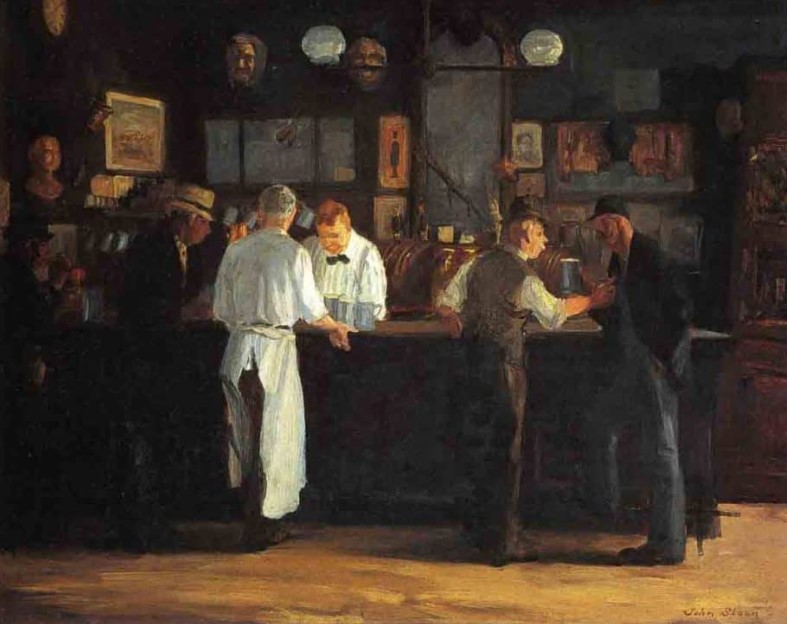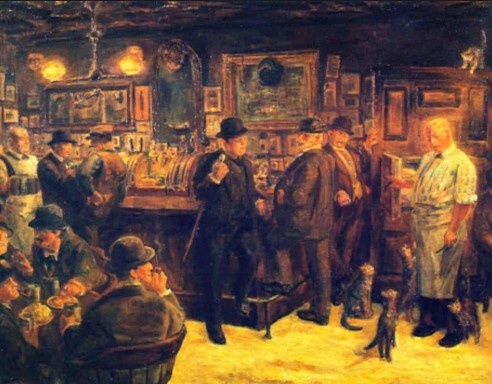EARLY SUNDAY MORNING
by Edward Hopper
7th Avenue, Greenwich Village NY
Greenwich Village is one of the world's most famous neighborhoods, located on the southwest corner of downtown Manhattan in New York City.
Steeped in history, the village is also known as "West Village" or simply "the Village." It has Broadway on the east, the Hudson River on the west, Houston Street on the south, and 14th Street on the north. Surrounding communities include East Village to the east and Chelsea to the north.
Originally a small farming community, the area surrounding the village was once marshland. It was referred to as "Sapokanikan" in the 16th century. The land was turned into a pasture by the Dutch settlers in the 1630s and then it came to be known as "Noortwyck."
In 1664, the village developed as a hamlet separate from the larger downtown Manhattan when the English occupied the Dutch settlement of New Amsterdam.
It officially became a village in 1712 and was first referred to as "Grin'wich" in the records of the Common Council. As a result of recurring yellow fever in New York City in 1820s, many people fled to the healthy area of Greenwich Village and remained there. The village was converted into a military parade ground and park in 1826.
With a history spanning nearly two centuries, Greenwich Village was a mecca to Bohemians, and they played a major role in propagating new political, artistic, and cultural ideas in the area.
Since the turn of the 20th century, the Village has been a destination to famous artists, writers, entertainers, and intellectuals, such as E.E. Cummings, Eugene O'Neill, and Edgar Allan Poe.
The village also remained home for political rebels such as John Reed and Marcel Duchamp who proclaimed the founding of "The Independent Republic of Greenwich Village." Further, the village's role as a center for movements is remarkable.
Presently, the Village is a vibrant area, dominated by some important monuments, beautiful townhouses, multitudes of dining areas, and a wacky serpentine layout of streets.
The Federal-style row houses, Greek Revival townhouses, and quaint carriage houses, apart from the office buildings of the late 19th century and towering 20th century apartment buildings, reflect the creative and diverse population of the Village.
The heart of the neighborhood is the historic Washington Square Park, which is a hub of activities such as chess playing, skateboarding, and walking or jogging. The Village is also the seat for some of the important educational institutions in the nation, such as New York University (NYU) and New School University.
The world's oldest gay and lesbian bookstore - Oscar Wilde Bookshop - is located here. Petrosino Square, Little Red Square, Time Landscape, Desalvio, Thompson Street, and William Passannante Ballfield are other important landmarks in the village.
Also, located here is The Cage, officially known as the West 4th Street Courts. It is one of the most important venues for the city-wide amateur basketball tournaments. In addition, the Village is the place for the renowned Halloween Parade - a mile-long parade of life-sized puppets and masqueraders that draws more than two million spectators.
Macdougal Street
Macdougal Street and Bleecker Street are two of the most famous and historical streets in all of Greenwich Village. They were the main streets that spawned such Bohemian Types as Jack Keroac of the Beat Generation known as Beatniks. Macdougal Street and Bleecker Streets and the area where they converge was the epicenter of Folk Music in Greenwich Village in the many clubs, cafes, and Coffee Houses back in the 1960s with such musical artists as Bob Dylan, Joan Baez, Maty Travers of Peter Paul & Mary, John Sebastian, John Phillips and Cass Elliot (Mamma Cass) of the Mammas & Pappas, Pete Seger, John Denver and others, and later on such notables as Jimi Hendrix at Cafe Wha, Steven Tyler and Aerosmith.
Map of GREENWICH VILLAGE
SUNDAY SAUCE is NEW YORK ITALIAN
Greenwich Village for a long time from the early 1900s to the early 1960s was primarily an Italian Neighborhood made up of immigrants of the Southern Italian enclaves of Naples and Sicily, as well as some from Genoa, Calabria, and Abruzzo. There are still a few great old Italian businesses left like; Monte's Trattoria (Since 1918), Raffetto Pasta Co. since 1906, and PORTO RICO COFFEE owned by the Longo Family Since 1907, and CAFFE REGGIO since 1927, which features paintings from the School of CARAVAGGIO and Rennaissance Benches from a Medici Pallazzo that can actually sit in as you sip your Italian Cappuccino and listen to Classical Music in a most delightful way. This is just a little taste of the charms of Greenwich Village New York.
Native Writer of Greenwich Village
Best Selling Greenwich Village Italian-American Author Daniel Bellino-Zwicke
Minetta Street
1928
I recall the first time when I first traversed from the rugged and rowdy street life of MacDougal onto Minetta Street, it was as if I entered a different time and place. Despite being sandwiched between the traffic frenzied Sixth Avenue of Americas and the bohemian (or hipster) line of stores on MacDougal, Minetta Street offers a pocket of serene-ness. It was not until I researched further did I realize that there are two streets perpendicular to one another – Minetta Lane and Minetta Street, which are commonly referred to as the “Minettas.”
Perhaps this transport to a different time has historical ties to its past of bucolic charm. From the firmly paved roadways, one would never guess that beneath it was a running, fresh stream, called Manetta. In the 1640’s, the plot of land which the Minettas resided on had no formal, paved streets. The ruling Dutch and “partially freed” slaves were permitted to purchase plots of land there, under the requirement that an annual fee was paid. This land came to be known as “the Negroe’s Farms.”
"What happened of this stream?” This query lead me to dig up research conducted by the Mannahatta Project, a collaborative effort of scholars, researchers, scientists to reconstruct and understand the natural ecology that vastly populated the space and was particular to Manhattan Island. Researchers of the Mannahatta Project were able to discover hundreds of ponds, streams, wetlands, valleys that were leveled out for the Commissioner’s plan in 1811 to redevelop the city streets to the grid system.
Due to the increasing industrialization in the city, many of these water sources were re-zoned for development. The Collect Pond, which provided one of the freshest water resources in Manhattan for 200 years, was polluted with chemicals from nearby tanneries and the overpopulation from the neighboring Five Points area.
Manetta stream in the 1820’s went into subterranean existence, and the Minetta’s in the coming decade came to increase in population. In 1830, three years after slavery had been abolished in New York City, 14,083 freed African-Americans lived in the area. Old dirt paths that branched off from farms were quickly converted to Minetta Street and Minetta Lane. This area came to be known as “Little Africa.” For several decades, the area lived peacefully as if they were in a suburb within a city. In the late 1870’s with the rise of pubs checkering adjacent streets near the Minettas, this invited various types of intermingling – bringing in crowds as diverse as Irish youth gangs and writers. One of the most infamous pubs towards Sixth Avenue and West Fourth, the Hell Hole, where Irish writer Eugene O’ Neill would frequent, was a rumbling house of violence due to the heavy alcoholic intoxication of pub visitors. Violence would often break out and Minetta’s reputation became tainted by its adjacent streets. In 1896, Stephen Crane called the Minetta’s, “until a few years ago, two of the most enthusiastically murderous thoroughfares in the city.” Minetta’s came to be dotted with speakeasies and brothels, oftentimes knifings and violence would erupt. At one point, the Minetta’s had the most active prostitution area in the Village. By 1912, the brothels were shut down and in 1917, Minetta’s reputation was known in guidebooks as “village bohemia.”
The quick transition from this violent history to the peaceful stabilization of Minetta still remains a wonder to me. I question whether part of turn around had anything to do with the city bombing of the Sixth Avenue end, close to the Minetta’s. I wonder if this was the City government’s effort to demolish the areas deemed “degenerative” as part of a city-wide effort to establish and beautify more public spaces.
I do believe though, that much of the tranquil charm of both Minetta Lane and Street can be attributed to Vincent Pepe, who in the 1910’s decided to contribute to the city redevelopment plan as a Greenwich Village developer. A young Italian immigrant who followed his father into the real estate industry of New York City, Pepe was able to leverage his connections to purchase several building, lots on the Minettas, including houses and tenement buildings. Pepe was able to combine 13 buildings to the west of Minetta Street and transformed the backyards into a common garden with a back entrance. To the east of Minetta Street, Pepe and his business partners were able to aquire 1,3 and 5 Minetta Lane and 17 Minetta Street. With a large stake in property ownership, Pepe was able to execute his vision in continuing to build spaces to support and enrich the growing community. Pepe stated in a promotional brochere “The artist, the writer, the creator of beauty in any medium – these are the men for whom the Minettas should be preserved.” The street zoning, with its unique angling and narrowness, was meant to provide a sense of enclosure from the rest of the city. In an article written in 1923 for the New York Times, the Minetta’s were said to be “As free from noise and as peaceful as though miles away.” Although indeed, Pepe’s vision materialized into reality, the area was home to a diverse population of residents beyond the artists and bohemian crowd.

The WAVERLY INN
The Waverly Inn is an old historical restaurant on Bank Street at Waverly Place in Greenwich Village , New York .
Built in 1844, the building was first used as an Inn & Bordello / Brothel. It later became a Coach House for horses and carriages before becoming a Tea House frequented by writers and poets, the likes of Robert Frost and Edna St Vincent Millay who lived nearby in the narrowest home in New York City.
In the 1920s it became what we know it as today "Ye Old Waverly Inn"

New York City’s Greenwich Village, or “the Village”, is located in Lower Manhattan on the West Side. Though now it consists of mostly upper middle class families, Greenwich Village once birthed cultural movements such as the Beat Generation and ’60s counterculture. As an artist’s haven, it was the East Coast’s bohemian birthplace. Broadway to the east, the Hudson River to the west, Houston Street to the south, and 14th Street to the north provide borders for the neighborhood.
In the 16th century, Greenwich Village was a marshland known as Sapokanican. It’s main inhabitants were Native Americans who used the Minetta Brook to fish for trout. The area became known as Noortwyck by the Dutch settlers who cleared area pastures and planted crops. By 1713, it was referred to as Grin’wich.
Greenwich (Grin’wich) Village survived the American Revolution as a pastoral suburb. After the war, the areas commercial life centered around fresh produce markets which were centered around the edge of the Hudson River. Washington Square Park was originally a potter’s field and public gallows after being purchased by the city in the 1780s. Whereas the area was originally secluded from the rest of the city, the outbreak of cholera in the late 1700s and early 1800s drove people to seek refuge in this neighborhood, which led to the construction of temporary housing and banking offices. Because of the outbreaks, the population quadrupled between 1825 and 1840. Middle-class merchants and tradesman soon became the majority of the area and subdivided farms and undertook landfill projects to accommodate the population of the area and make room for blocks of Federal style row houses.
The character of the neighborhood was changed in the late 19th century by the domination of immigrants. As the French, Irish, and Italian moved in, the area transitioned to a culture of bohemianism. The Washington Square Arch was constructed in marble and the area was memorialized by the writings of Henry James and Edith Wharton, Washington Square and The Age of Innocence, respectively.
With the growing of New York University came the growth of art clubs, picture galleries, learned societies, literary salons, and libraries. Entertainment such as theaters and shopping also began to gain prolific exposure in the area.
At the turn of the 20th century, the Village was ethnically diverse and quaint. By World War l the area had settled into its reputation for nonconformality and low rent. During Prohibition local speakeasies attracted uptown patrons. Decrepit row houses were remodeled into “artistic flats” for the well-to-do, and in 1926 luxury apartment towers appeared at the northern edge of Washington Square. The stock market crash of 1929 halted the momentum of new construction.
During the 1930s, galleries and collectors promoted the cause of contemporary art. Sculptor Gertrude Vanderbilt Whitney opened a museum dedicated to modern American art on West 8th Street, now the New York Studio School. The New School for Social Research, on West 12th Street since the late 1920s, inaugurated the “University in Exile” in 1934.
The beat movement took hold in the 1950s with the opening of MacDougal coffee houses and storefront theaters on Bleecker. During the 1960s a homosexual community formed around Christopher Street and in 1969 a confrontation between police and patrons culminated in a riot known as the Stonewall Rebellion. This started a nationwide movement for gay and lesbian rights. Greenwich Village became a rallying place for antiwar protesters in the 1970s and for activity mobilized in response to the AIDS epidemic in the 1980s.
The Villages dedication to historical and ethical preservation has been a long held neighborhood tradition and the neighborhood remains as a hub for artists, locals, and “immigrants” looking for a neighborhood specializing in nonconforming social standards, although the prices to live here are geared more towards the upper-middle class.
.





















